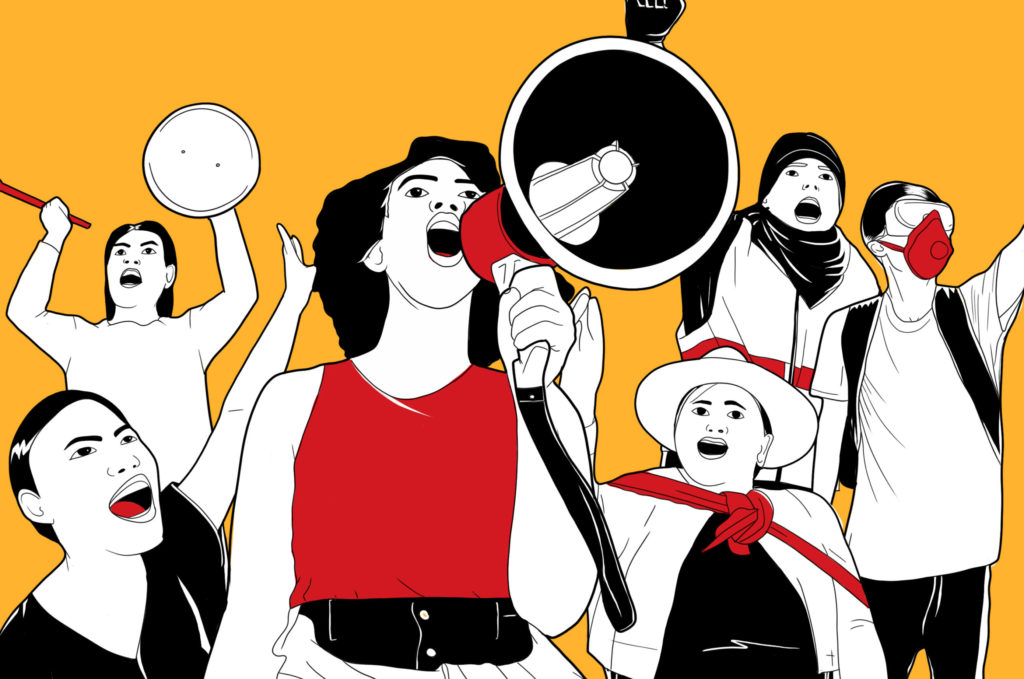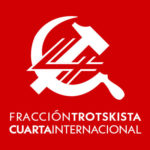Manifesto in PDF format
Español | Português | Français | Deutsch | Italiano
The Capitalist Disaster and the Struggle for an International of Socialist Revolution
We live in an era of economic, social, and political crisis — an era which has seen the renewal of worldwide class struggle. These conditions highlight the need to build a movement for a revolutionary socialist international, one that is based on the lived experience of the workers and oppressed peoples who are beginning to confront capitalist governments the world over.
In 2013, our tendency, the Trotskyist Fraction — Fourth International published the Manifesto for a Movement for a Revolutionary Socialist International — Fourth International.
Since its release, the program of the Manifesto has been endorsed by The Organización Socialista Revolucionaria of Costa Rica, the Frazione Internazionalista Rivoluzionaria of Italy, and the Corriente Socialista de las y los Trabajadores of Peru.
Last year, the Workers Left Front — Unity (FIT-U) of Argentina and several of its members’ sister organizations organized a Latin American and U.S. Conference in order to debate the agreements and differences of various groups who support the struggle for socialist revolution.
The purpose of this manifesto, released by the Trotskyist Fraction — Fourth International, is to resume the debate on the need for a movement for a revolutionary socialist international. It is aimed at the youth, the working class, and the oppressed who have been at the forefront of the wave of mass rebellions and general strikes around the world. This includes the Black Lives Matter movement in the United States, the mass rebellion in Chile, the fight against the right-wing coup in Bolivia, and the mass strikes and Yellow Vest movement in France. It includes those who have participated in the women’s movement around the world, in land occupations, strikes, and blockades. It includes those in Brazil confronting Bolsonaro’s government independently of the capitalist parties. It includes Venezuelans who are confronting U.S. imperialism, independently and without supporting Maduro’s increasingly repressive, authoritarian regime as it becomes increasingly submissive to imperialism. This manifesto is intended for the Mexicans organizing independent of both the “progressive” government and the right-wing opposition, as well as the countless movements across Southeast Asia, led by the heroic working class of Myanmar. It is for all who have taken to the streets to fight exploitation and oppression, who are urgently seeking a political alternative to capitalism, combating the commonsense notion—promoted by reformists and decades of a neoliberal onslaught—that all we can do is fight for crumbs.
We aim to recover a revolutionary, internationalist, and socialist perspective in order to destroy a system that deserves to perish. This manifesto is intended for Trotskyist organizations and individuals who wish to apply the lessons of class struggle to the task of building a movement for a Revolutionary Socialist International. In this manifesto, we consider the experiences of intense class struggle in the U.S., France, Chile, and Argentina, and the comparative influence of the socialist and revolutionary Left. We will seek to summarize and analyze today’s most important expressions of class struggle.
The Ongoing Crisis and the Present Era of Crises, Wars, and Revolutions
The pandemic has led to an acceleration of the global economic crisis that was opened in 2008 by the collapse of Lehman Brothers and was never resolved. As in 2008, during the pandemic, big businesses were bailed out by governments, while millions of working people have lost jobs or income, or were forced to continue working in precarious conditions. Three million people are dead of coronavirus, and another 150 million risk sinking into extreme poverty according to the World Economic Forum.
The relationship between this crisis and the contradictions of capitalism is clear.
Big corporations, abetted by national governments, have plundered nature, clearing jungles and forests for the expansion of agribusiness. This has resulted in the spread of viruses that were previously found only in animals in remote habitats. The creation of “flat” spaces for large-scale chicken and pig farming and monocultures of soybeans and palm oil (in the case of the Ebola outbreak), is a key factor in the rise of deadly disease outbreaks, including the current pandemic. The new coronavirus spread rapidly — faster than any virus before it — following the same circuits that connect global just-in-time supply chains. While human viruses have frequently followed the flow of goods (the bubonic plague, for example, spread through trade routes for years), the speed and massive scale of globalized capitalism has created a scenario in which diseases can spread throughout the globe in a matter of weeks. This highlights the fact that capitalism not only makes it impossible to establish a harmonious relationship between humans and nature, but that it also increasingly destroys both. In this context, political projects like those of the progressive wing of the Democratic Party in the United States, the Green Party in Germany, or the “progressive” government in the Spanish State, along with NGOs and other social bureaucracies, foster illusions in green capitalism. The “Green New Deal” and similar reformist projects seek to co-opt the leaderships of environmental activist movements and turn them into “progressive” agents of capital. But imperialist governments will never become the agents of environmental and social progress.
Amid the crisis, the big bourgeoisies and their governments have sought to rebuild their power as they recover from the losses generated by the contraction of the global economy. The United States was hit hard by the pandemic and resultant economic crisis from March to June of last year: GDP dropped 32.9 percent during the second quarter of 2020. The Biden administration has just passed a $1.9 trillion Covid relief bill, part of which will be used to inject cash directly into the pockets of low-income sectors as a preventive measure. Though these policies are temporary, they have been replicated by practically all national governments, albeit with differing specifics and with obvious unevenness between imperialist and poor countries. Simultaneously, capitalist governments have guaranteed exorbitant profits for pandemic speculators, disbursing huge amounts of money directly to corporations and banks. A recent report from the Institute for Policy Studies shows that since the pandemic began, the fortunes of U.S. billionaires have increased collectively by a trillion dollars. According to Bloomberg magazine, the world’s 50 richest people have seen their wealth grow by $782 billion. These include Jeff Bezos, Elon Musk, and Bill Gates. Bezos in particular has made a staggering $69 billion since the pandemic began. Other individuals whose fortunes have increased are Facebook’s Mark Zuckerberg and Google founder Sergey Brin. In France, billionaires like luxury goods magnate Bernard Arnault, the third-richest person in the world, made $214 billion. The wealth of 73 billionaires in Latin America increased by $48.2 billion in the last year. According to an Oxfam report, the net worth of Brazil’s 42 billionaires increased in total from $123.1 billion in March to $157.1 billion in July, while the seven richest people in Chile saw their wealth increase by 27 percent, totalling a collective $26.7 billion.
At the same time, national state debts have increased significantly. According to the IMF’s calculations, the national debt of 30 countries exceeded 100% of their GDP in 2020. Among the 20 countries with the highest debts are major world powers like Japan and the United States. But this situation is particularly dangerous for peripheral and semicolonial countries, from Angola to Argentina, because of the potential for debt crises, especially if interest rates begin to rise. Private debt and the proportion of “zombie” corporations, which are supported by government aid and debt, have also grown.
Wall Street celebrated as millions lost their jobs. Across Latin America, 55% of the labor force—roughly 140 million people—are part of the informal economy, and nearly one in five lives in overcrowded conditions. Up to 52 million people could sink into poverty in Latin America and the Caribbean as a result of the pandemic. As the rich amass more wealth, new attacks are launched against the working class. The imposition and generalization of precarious forms of employment and temporary work, alongside higher retirement ages, have been widely imposed by governments on their working masses. Meanwhile, these governments have distributed paltry subsidies—without true universal access and for a limited time—to give people the bare minimum to survive the worst of the pandemic.
The collapse of health systems in almost every poor country, and even in imperialist countries like the United States, the Spanish State, and Italy, has shown the social catastrophe caused by decades of neoliberal privatization. The current “vaccine war” is yet another example of the irrational nature of capitalist production. While politicians pontificate about the “fight against the pandemic,” they are unwilling to even temporarily suspend patents, preventing the spread of scientific knowledge and the fair distribution of vaccines. This has only increased the profound inequality between imperialist and oppressed countries. Africa, which has been pillaged by Europe for centuries, is perhaps the most extreme case of poverty created by the international division of labor, whereby the oppressed countries of the world are plundered by imperialist countries. The embargoes, sanctions, and attacks by the United States and its allies on countries such as Venezuela, Iran, Cuba, and, most especially, Palestine, have led to truly dire situations.
The crisis of neoliberalism has resulted in political polarization, including the emergence of far-right organizations like the Proud Boys and events like the violent assault on the U.S. Capitol by Trump supporters. The rise of proto-fascist groups in the U.S., where the Klu Klux Klan has a long history, has led to a debate on self-defense among Black Lives Matter organizations. The weakening of neoliberalism has also created crises in bourgeois parties and a rise in class struggle.
The growing tensions between China and the United States, on the one hand, and the tensions between the different imperialist blocs, on the other, foreshadow greater confrontations between states, as shown by the growing militarism among the major world powers. The United States plans to spend $741 billion on its next military budget. The National Defense Authorization Act for fiscal year 2021 includes a $3 billion increase over the previous year to bolster the United States’ aggressive position against China (including military, economic, and political belligerence). Reactionary wars, such as those in Nagorno-Karabakh, Yemen, and Syria, among others, are a consequence of the emergence of intermediate global powers and come in the context of the decline of U.S. imperialism, which is losing its ability to impose its own world order.
In the Middle East, the defeat of the Arab Spring led to the emergence of dictatorial and reactionary regimes. While the United States maintains its military presence in Iraq and Afghanistan, the Palestinian people continue to be subjected to colonial occupation by the state of Israel; like the Kurdish people, they are deprived of the basic democratic right to have their own state.
The ongoing crisis has demonstrated both the impossibility of indefinite growth based on the model of neoliberal “globalization” and the limits of attempting to return to isolationist and protectionist policies. The “populist” rhetoric of figures like Trump proved to be sheer demagoguery. At the domestic level, public services like health, education, and housing were gutted, following the trend of previous administrations. At the international level, Trump’s “America first” policy resulted in a series of attempts to improve the United States’ position in relation to China, Russia, and the European Union, breaking alliances and multilateral agreements that were characteristic of previous administrations, particularly that of Obama.
The decline of U.S. hegemony continues and it remains to be seen whether the Biden administration can counter the growing instability that has taken over the world order in recent years. In domestic politics, a sign of this decline is the crisis of the Democratic and Republican Parties in the context of the deteriorating economic situation, the intensification of racism, and the health crisis. In response to the crisis, the Biden administration is taking moderated “Keynesian” measures, the scope of which remains to be seen. These measures go in the same direction as those taken by Trump at the height of the pandemic, disregarding the notion of “small government” and “fiscal responsibility,” which Democrats and Republicans alike supported for decades. One of the objectives of Biden’s ambitious infrastructure plan is to increase the United States’ competitiveness in relation to China. The plan has already led to conflict between the two parties, as well as with sectors of hegemonic capital in the U.S. due to the increased corporate tax rate, however minimal and the small concessions granted to unions.The $1.9 trillion American Rescue Plan offered only short-term measures. The proposed infrastructure bill offers medium-term initiatives. It is opposed by the Republican Party and a sector of U.S. capital, and it could be rejected by the moderate Democrats in the Senate who are under pressure to oppose it. In the long term, it is unclear which driving forces of accumulation U.S. capitalism could rely on to achieve an economic recovery that would take it back to pre-2008 conditions. What is clear is that the ruling class and the Biden administration aim to divert and co-opt the working class and “social movements,” by relying on the work of labor bureaucracies and NGOs.
At the international level, it is clear that the leading world power is finding it difficult to impose its policies at the global level and re-create the consensus of the past, when the U.S.’ allies worked together to consolidate its hegemony.
In addition, the pandemic has been a catalyst, exposing all the contradictions of capitalism at all levels, including those between the social character of production and the private form of appropriation, of which the most irrational example is the vaccine patents. It has also laid bare the contradictions between the international character of the economy and the national form of states, which is demonstrated, on the one hand, by the signs of trade wars between the United States and China and the tensions between the United States and the European Union, as well as tensions within the U.S. itself. On the other hand, these contradictions have led to an increase in imperialist pressure on dependent countries through IMF policies. The recent mass processes of class struggle in several countries have also shown that the fire of class confrontation still burns bright, although the trend of the most significant events so far is revolts and rebellions, rather than revolutions that pose an existential threat to capitalist states.
These factors are part of the historical and strategic context of crises, wars, and revolutions — the same category which classical Marxists use to characterize the imperialist era in the early 20th century, thus demonstrating the continued relevance of anti-imperialist and socialist struggles. Despite the capitalist restoration in the bureaucratized workers states and several decades of neoliberal attacks against the standard of living of the working class and oppressed masses around the world, capitalism has not only failed to resolve its contradictions and tendencies toward the outbreak of crises, but has also taken them to an extreme that is increasingly exposing its incompatibility with the survival of the human species and the planet.
The Return of Class Struggle
Since before the pandemic, we have witnessed an increase in class struggle in several countries. From Lebanon to Ecuador, France, Bolivia, Chile, the United States, Algeria, and Hong Kong, the working class, women, youth, the Black movement, and broad sectors of the oppressed masses have taken to the streets. These groups have protested against the austerity policies of governments instituting the IMF’s formulas, against racism and police abuse, and against the coup in Bolivia, among other examples.
For a few months, the quarantines and lockdown measures imposed in most of the world reduced global struggles. But the pandemic also showed the importance of the role of essential workers, without whom the world would ground to a halt, and who gained confidence in their own strength. Sectors of the working class with precarious jobs began to organize into new unions, or lead protests and partial strikes for better working conditions in different countries — from day laborers and logistics workers to Amazon employees, nurses, janitors, and teachers, among others. At the height of the pandemic in the United States, a huge, combative mass movement emerged against racist police violence, triggered by the murder of George Floyd.
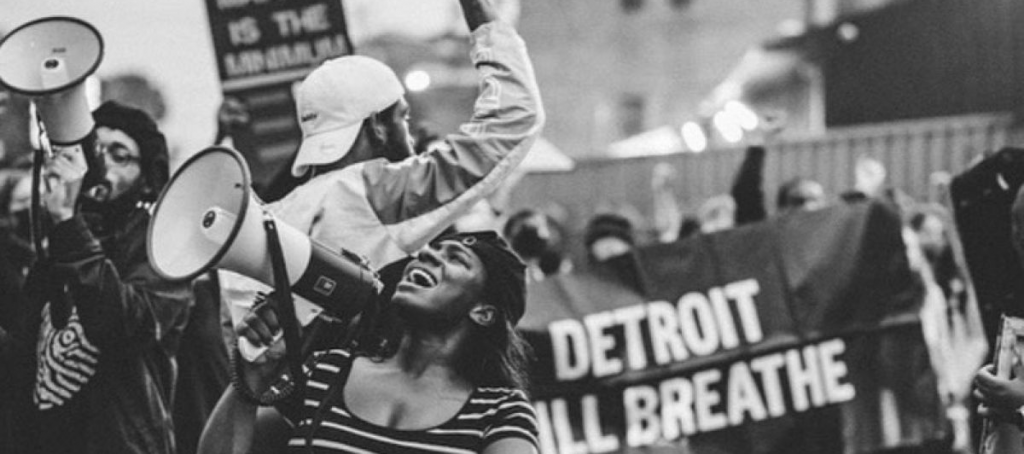
The world later witnessed massive workers’ strikes and peasant struggles in India as well as massive and fierce resistance to the military coup in Myanmar. Workers around the world also participated in more small-scale but nonetheless significant struggles, such as the Grandpuits oil workers’ strike against the giant Total in France and class struggles in countries like Italy and Argentina. New generations have joined the struggle in recent years, both in defense of the working class and for the specific demands of the women’s movement, which has made vital progress in terms of struggle and organization. Other struggles have gained relevance, such as the fight against the climate crisis, in which young people play a central role.
According to an analysis of social unrest in 2019 by the risk assessment firm Verisk Maplecroft, 47 countries — nearly a quarter of the world — experienced major “civil unrest” in 2019 alone. 2020 saw new mobilizations and mass demonstrations; for example, in Belarus, Thailand, the far east of Russia, the massive strikes in Indonesia, the rebellion that ousted the government in Peru, and the growing unrest in much of the rest of the world. Some of these struggles are still continuing. From 2008 to 2020, there were important general strikes and working-class struggles in India, South Africa, Brazil, Chile, Colombia, South Korea, Algeria, and France, among other countries. Mass mobilizations became increasingly radicalized in response to police repression.
The first cycle of class struggle started in late 2010 with the revolutionary uprisings in the Middle East, where events in Egypt and Tunisia were particularly intense. This wave spread to other countries, in the form of Occupy Wall Street in the United States and the Indignados/15M movement in the Spanish State. It also resonated in Latin America with the Chilean student movement in 2011 and #YoSoy132 in Mexico. That cycle ended in defeats: in Egypt, there was a military coup, and in Greece, Syriza ended up implementing the Troika’s austerity measures. In the case of Libya and Syria, it ended in reactionary civil wars. The cycle in some cases led to electoral deviations of the movement, such as in the Spanish case, thanks to the actions of neo-reformist tendencies like Podemos. Nonetheless, this wave represented the masses’ first steps after the 2008 capitalist crisis.In the framework of a weak global economy, with tendencies toward recession, 2018 saw the beginning of a new wave of class struggle. In France, the Gilet Jaunes (Yellow Vests) emerged. Their radicalization inspired subsequent struggles, such as the strikes against Macron’s pension reform. The spark of the Yellow Vests spread internationally in 2019 with the rebellion in Hong Kong and the uprisings in Algeria and Sudan. Countries like Lebanon and war-torn Iraq followed suit. In Latin America, we saw popular revolts and rebellions in Ecuador, Colombia, Puerto Rico, and Chile, where we saw the return of mass strikes.
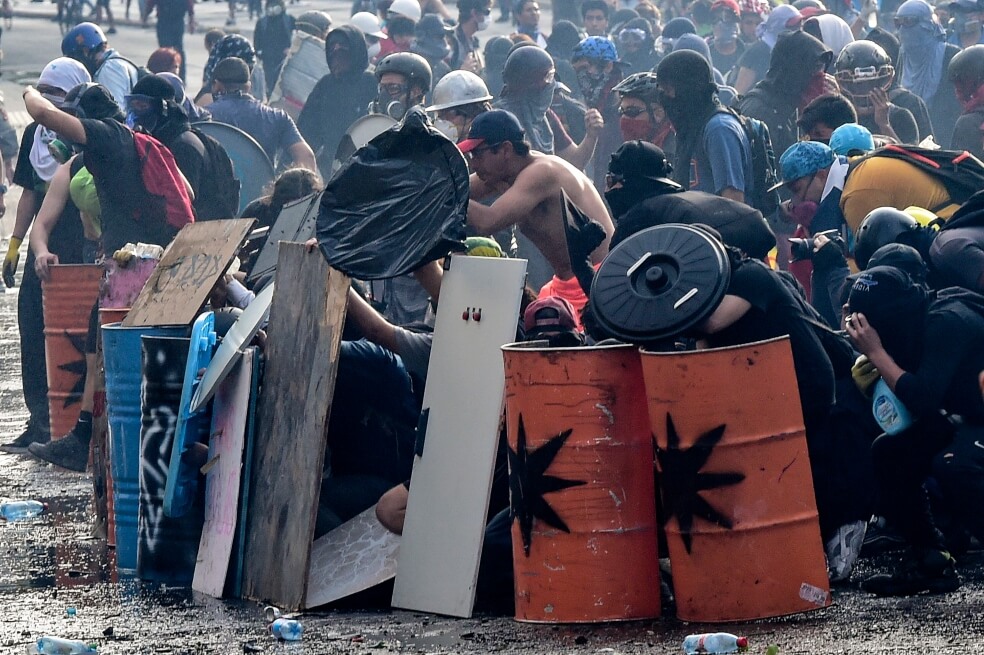
Some of these mass strikes have taken place amid huge mobilizations in streets and squares around the world, such as in Hong Kong, Chile, Thailand, Ukraine, Lebanon, and Iraq. The European Trade Union Institute estimates that from 2010 to 2018, there were 64 general strikes in the European Union, almost half of them in Greece. More generally, the ILO estimates that there were 44,000 work stoppages in 56 countries from 2010 to 2019, mainly in factories. The ILO’s own report, however, notes that due to limitations in the data, the number of strikes could be much higher.
The new waves of revolts and popular rebellions that shook different parts of the world were limited by the trade union bureaucracies and reformist parties that diverted the power and action of the masses. That is why these important responses to the capitalist governments’ attacks — which included methods like general strikes and in some cases violent confrontations in response to police repression — did not go beyond pressure on the regimes. Nonetheless, they are the basis for new processes of class struggle and the emergence of new vanguard sectors of the working class and the poor masses. These powerful responses will help recompose the proletariat’s subjectivity. The connection between class struggle and the political radicalization of vanguard sectors is fertile ground for the emergence of revolutionary parties, revitalizing the ideas of revolutionary Marxism.
The Strength of the Working Class
These processes of class struggle are taking place in a framework in which the working class maintains its structural strength. According to the International Labor Organization (ILO), the world’s labor force grew 25 percent from 2000 to 2019. The number of employed people went from 2.6 billion to 3.3 billion in the first two decades of the 21st century. Of these employed people, according to the ILO, 53 percent received a wage or salary (compared to 43 percent in 1996). Thirty-four percent of them are considered self-employed workers (compared to 31 percent in 1996). Eleven percent are collaborating family members (less than half of the 23 percent they represented in 1996); and 2 percent are employers (who accounted for 3.4 percent in 1996). In the same period, services grew by 60 percent, while the labor force employed in industry grew 40 percent.
Capitalism has integrated even the most elementary work performed by families in remote parts of the world into its “global value chains.”
Contrary to the fantasy of a “postindustrial” world, the workforce employed in factories grew from 393 people million in 2000 to 460 million in 2019. The industrial workforce (which also includes construction and mining) grew from 536 million to 755 million in the same period. Communications and urban services employed 226 million people in 2019, compared to 116 million in 2000. Major industries have been relocated outside the United States and Europe, and certain activities have been reconverted. This has created two big poles in the global working class. While there are millions of workers in large industries based in Asia or peripheral countries, there is also a concentrated logistics and distribution sector with particular weight in the most developed capitalist countries, but which in reality is present in all the world’s big urban centers. Added to this is the growing proletarization of sectors of workers who in the past were socially and culturally linked to the urban petty bourgeoisie. These workers — public employees, service workers, health care and education workers — have seen their living conditions deteriorate rapidly. Sectors such as oil, energy, transportation, ports, and logistics occupy major strategic positions and can paralyze the circulation of goods and people. Workers related to state functions in communities can create a link between the organized working class and the urban poor.This reality of the working class and its strength from a strategic point of view also puts “post-capitalist” ideologies into doubt. These ideologies assume that the current system is advancing toward an almost total automation of production, which would make the workforce superfluous, replacing human labor with machines. Different studies have shown that advances in recent decades in artificial intelligence, robotization, and automation of production have been accompanied by a lengthening of the working day. Via mechanisms such as the annualization of working hours, banked hours, and other forms of precarious working conditions and attacks on the previous victories of the working class, capitalism has shown that it can develop technology — but only if it can be used for capitalist profit, and not for the needs of the masses.
The Struggle Against Racism and Imperialist Capitalism
The working class can only triumph if it sets out to liquidate imperialist capitalism. To accomplish this, it must articulate the demands of all oppressed sectors on the political plane. The struggle against racism and xenophobia has shown its full force in recent years. This was demonstrated by the emergence of Black Lives Matter (BLM) in the United States, leading a rebellion in the heart of imperialism. The BLM movement revealed to the world the profoundly racist character of the U.S. state and the marriage between capitalism and racism. This marriage is evident not only in the murderous actions of the police toward people of color, but also in the usefulness of racism to capital. Capital in general uses racism to build up an industrial reserve army and to divide the working class into first-, second-, and third-class workers, according to their ethnic origin or immigration status. That is why there are reactionary immigration laws, border walls, deportations, and detention centers. These policies maintain the institutional and police violence that the United States imposes on Mexico, Central America, and the Caribbean. European imperialisms do the same to the countries of Eastern Europe, Africa, and Asia.
The European Union spends billions on border policing so that Frontex, the European Border and Coast Guard Agency, can prevent refugees from crossing the Mediterranean. As a result, an average of eight people die every day on those waters. The EU has effectively suppressed the right to asylum, with detention camps on its external borders, combined with a discourse that seeks to divide migrants between those who supposedly “deserve” asylum and those who do not. In this way, a large majority of refugees are criminalized, thrown into even worse living conditions, and condemned to super-exploitation and racist oppression.
The working class in the U.S. and Europe is multiracial. The pandemic revealed that African American, Latinx, and Caribbean workers constitute a fundamental part of the so-called “essential workers” in the United States — as do Turkish, Kurdish, Arab, and African workers in Europe.
In the context of the pandemic, the murder of George Floyd led to the biggest movement in recent history in the United States. This movement stood up to the police and made the point that racism is a structural problem that is closely linked to the history of how state power was established, and linked to all the country’s institutions. The protests against lockdowns and BLM, and then the storming of the Capitol, showed a convergence of old and new racist organizations. The Far Right burst onto the center of the U.S. political scene, and this was no coincidence.
The ongoing crisis of U.S. imperialism is opening up new scenarios of class struggle and creating new possibilities for the proletariat to act. But no revolutionary action in the United States can succeed without taking up the banners of Black liberation and the fight against the oppression of ethnic minorities and immigrants. The left wing of the Democratic Party — which is aligned with the union bureaucracy, which historically helped maintain racism inside the workers’ movement — belittles the struggle against racism, calling it “identity politics.” The bureaucracies that lead Black struggle are agents of the Democratic Party, and they separate the struggle against racism from the struggle against capitalism. Both are opposed to struggle against systemic racism and capitalist exploitation, and both lead to a dead end. Black workers must take the lead in the struggle of the mighty, multiracial U.S. proletariat.
It is necessary to raise the banners of anti-racism as high as possible. This means a relentless struggle against proto-fascist groups and the racist police. It means uniting Black struggle with class struggle against the bosses, the big bourgeoisie, and the imperialist state.
The historical examples of the big strikes in Detroit in 1968 showed that it is possible to do so. More recently, we have seen different examples of workers’ organizations that went on strike to support BLM and condemn the murder of George Floyd. A one-day strike on June 19, 2020 paralyzed 29 ports on the West Coast. There were hundreds of actions in Amazon warehouses, supermarkets, and fast food restaurants across the country repudiating police violence. We saw anti-racist protesters fraternizing with essential workers in common actions. The campaigns of certain local workers’ organizations, led by the rank and file, demanding that union leaderships disaffiliate police unions from the labor councils, are another example of these concrete tendencies toward unity.
Although BLM has since retreated from the streets, and was diverted toward the (lesser-evilist) vote for Joe Biden and Kamala Harris, the embers of the movement are still burning. This can be seen in the emergence of dozens of anti-racist vanguard organizations in big and small cities. These include organizations that are beginning a process of radicalization, fighting for the political independence of the movement from the Democratic Party and increasingly embracing a class-struggle perspective — uniting the anti-racist struggle with the anti-capitalist struggle. An example of this is the group Detroit Will Breathe, an organization that formed in the heat of the movement in this important city in the Rust Belt.
This vanguard, which emerged in the heat of BLM, coexists with and is part of a left-wing ideological phenomenon that has been developing since Occupy Wall Street. This continued with Bernie Sanders’s campaign and led to the rapid growth of the Democratic Socialists of America (DSA). While the DSA captured the imagination of millennial socialists, it has adapted itself to work for the left wing of the Democratic Party, which in turn works for the new Biden administration.
Along with a new vanguard, important local struggles have emerged which have the potential to gain national attention. This was the case with the attempt to unionize more than 5,000 mostly Black Amazon workers in the community of Bessemer, Alabama. Even the bourgeois press has had to recognize that the Amazon campaign was a profound expression of the symbiosis between the anti-racist struggle and the struggle against big corporations like Amazon. Despite being defeated, this campaign was a first battle on the road to winning a union at the giant company owned by Jeff Bezos.
In Europe, too, the struggle against racism is closely linked to the struggle against imperialism, which leads to wars, migration, and death in the periphery, in Africa and the Middle East. That is why it is necessary to establish an anti-imperialist program that opposes military interventions and arms exports by the central capitalist countries. In 2018, there was a wave of strikes in Europe with an exemplary character: Dockers in Le Havre, Genoa, Santander, and Marseilles refused to load the Saudi cargo ship “Bahri-Yanbu” with war material. They went on strike with a truly internationalist message: “Ports closed for war — ports open for migrants.”
For the Unity and Hegemony of the Working Class
The most dynamic expressions of class struggle are taking place with the political interventions of the oppressed in multiclass movements. This has divided the international Left between those who abstain from all participation and those who opportunistically adapt to the leaderships of the so-called social movements or the union bureaucracies without fighting for a working-class and revolutionary leadership.
When the Yellow Vest rebellion began in 2019, the first response of the Emmanuel Macron government was to identify the movement with the Far Right. Union leaders followed suit, including the CGT and, unfortunately, even sectors of the Far Left. The movement’s participants were heterogeneous, its organization was limited, and the level of class consciousness was low. This meant that there was a permanent danger that the reactionary minority of the Far Right could grow stronger. But the movement’s radicalism, its demands for economic equality, and its democratic aspirations gave it a progressive course. In this context, the role of the revolutionary Left was to fight the far-right minority within the movement, both politically and ideologically, instead of turning its back on the Yellow Vests. That is why Révolution Permanent, as part of the NPA, fought for the democratic self-organization of the movement. Action committees were necessary to extend the movement and to unify it with the principal bastions of the working class, the youth, and the poor neighborhoods, until Macron was defeated with a general strike. At the same time, we fought within the workers’ and students’ organizations where we were active, and in the unions, so that these organizations would not only express solidarity but also join the movement. This began with the Inter-Station Collective, which had emerged in the immense rail workers’ strikes of 2018, and the Committee for Truth and Justice for Adama. With these two structures, we launched, when the Yellow Vest movement first began, what was called the “Saint-Lazare Pole.” This pole of attraction for workers, youth, and people from the poor neighborhoods called on people to gather at the Saint-Lazare railway station in Paris. The marches joined the Yellow Vests and demonstrated together with them in organized blocs, raising their own demands. This pole was able to unite several thousands in the streets and hundreds in assemblies. It played an important role in breaking the isolation that the government and the trade union bureaucracy sought to impose on the movement.
This is an example of a policy of hegemony toward social sectors that are not part of the working class but have convergent interests with it. Another example is the alliance between the environmental movement and the striking oil workers at the Total refinery in Grandpuits, France. The bosses wanted to close and restructure the refinery, supposedly as part of an ecological transition. The striking workers pointed out that there was nothing ecological about Total’s plans. They denounced the role of the oil company in peripheral countries such as Mozambique and Uganda. They argued that only the workers could organize a truly ecological transition. This could not be done at the expense of hundreds of jobs and of the safety of workers and residents. Similarly, the workers at the Harland and Wolff Shipyard in Ireland fought the closure of their workplace while also raising the demand for “clean energy.” In opposition to “greenwashing” and appeals to big capitalists, who are themselves the biggest killers of the climate, these struggles are beacons of a working-class solution to the climate crisis. Such examples must be held up and generalized for the youth, who are standing at the crossroads of socialism and barbarism in the fight against climate change.

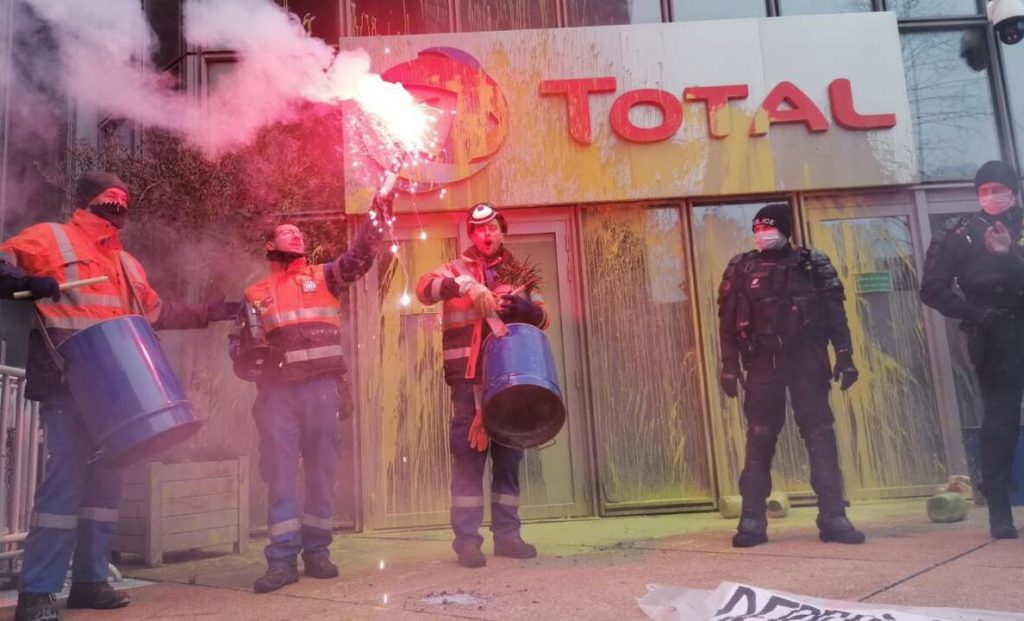
The working class must also take up the banners of the indigenous peoples who have been historically oppressed by the capitalist states, and support their struggles in defense of their lands throughout Latin America. We know that the pro-imperialist Right that attacks the working class is the same that set fire to the wiphala, the indigenous flag, at the Bolivian presidential palace, an incident that demonstrated the racist character of the coup in Bolivia, which was also an attack on the Aymara, Quechua, and Tupi Guarani communities. Indigenous peoples have histories of resistance, such as the heroic struggle of the Mapuche people in Chile and Argentina. The alliance between workers, peasants, and indigenous peoples is a strategic necessity in the fight against the capitalists and their institutions. This alliance, however, is inconceivable unless the workers take up the demands of indigenous peoples as their own. This begins with recognizing the right to self-determination, in the context of the failure of institutional “integration” defended by bourgeois governments and “progressive” movements. It also includes the demilitarization of indigenous communities and land distribution based on the expropriation of agribusiness and the timber industries. In Bolivia, the resistance to the coup that developed at the Senkata gas plant, shows the potential of an alliance between workers, peasants, and indigenous peoples.
It is also worth highlighting the importance of uniting the struggles of the working class with those of women and LGBTQ+ people, which have become truly massive around the world. No project of revolutionary social emancipation can avoid taking up womens’ demands — they are vital and central, since they question the policies of the ruling class and their states. Capitalism maintains women’s oppression, which includes intensifying violence against women, the denial of their most basic rights, and worsening living and working conditions. In the last few years, an important women’s movement has emerged in different countries. We have actively participated in assemblies and coalitions, organizing the so-called “women’s strikes” and fighting within these movements to build up a revolutionary, socialist, and class-struggle wing. In this spirit, we pushed back against both liberal feminism and separatism — which refused to unite the women’s struggle with the rest of the oppressed — as well as against punitivist tendencies that aim to strengthen the repressive mechanisms of the bourgeois state as a response to male violence. We also fight the co-optation of the women’s movement by “neoliberalism with a progressive face,” represented by the Democratic Party in the U.S., the PSOE-Podemos government in the Spanish State, or the “ministerial feminism” of Kirchnerism in Argentina. At the same time, we have put all our strength into the struggles of women workers against capitalist exploitation, for the right to housing, and against institutional racism. During the pandemic, working-class and immigrant women have been on the front lines of the fight against the coronavirus. Today they deserve to be on the front lines of class struggle. To fight for this perspective of socialist and working-class feminism, we are building up the socialist women’s organization Pan y Rosas (Bread and Roses) in each country and internationally.
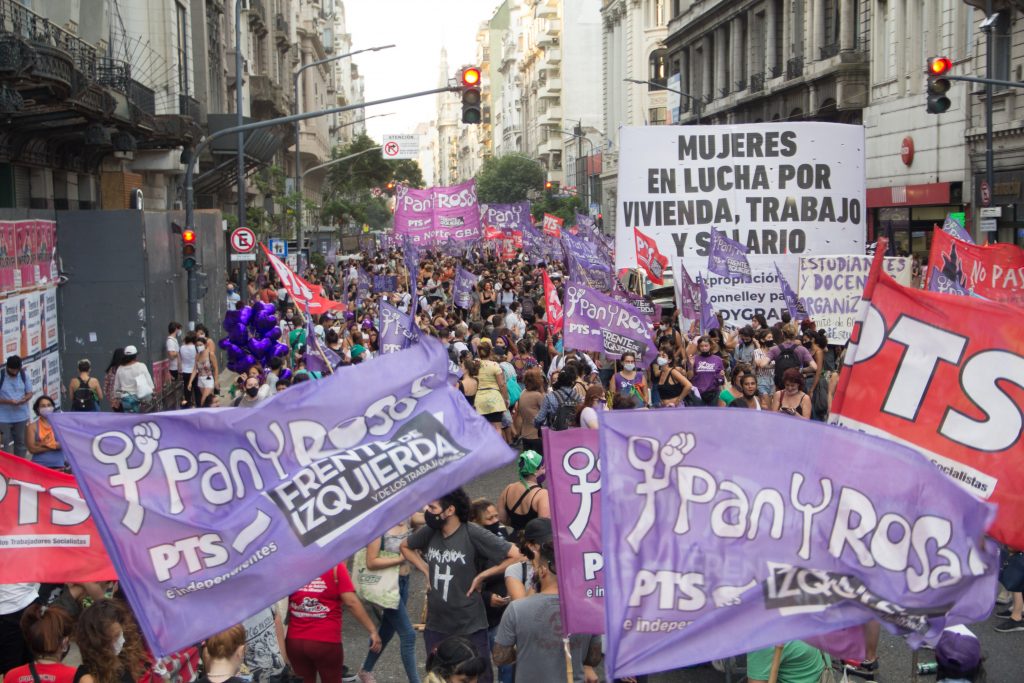
If we take into account the struggle against racism and the women’s struggle, working-class unity involves not only struggling for equal rights on the economic level but also taking up the specific demands of all the sectors that form the different parts of the working class in a social sense. Historically, Marxism referred to this as a policy of workers’ hegemony: building an alliance between the working class and other oppressed social sectors. Linking the demands of the oppressed with the objective of overthrowing the capitalist regime is indispensable today for achieving working-class unity.
Polarization, Bonapartist Tendencies, and the Defense of Democratic Rights
Amid the capitalist crisis, nationalist and right-wing “populist” parties and groups have experienced rapid growth, especially in Europe and the United States. We have witnessed far-right phenomena ranging from Trump in the United States to nationalists from the Visegrád Group (Hungary, Poland, Slovakia, and the Czech Republic). Their program is to attack the most basic democratic rights of the oppressed, under the guise of being “anti-establishment.” They target sectors of the working class and the poor along with women, immigrants, and LGBTQ+ communities. They give fuel to racist and xenophobic prejudices (anti-Semitism, Islamophobia, anti-Romani racism). They declare the “Christian roots of Europe,” and present their countries as “guarantors of the faith” against “foreign invasions.” Each of these parties and figures aim to strengthen an increasingly authoritarian executive: concentrating power in the hands of the ruling party, establishing presidential control over the institutions of the state, implementing increasingly draconian control of the media, carrying out repression, and restricting voting rights among other measures.
In Brazil, this global far-right tendency is represented by Jair Bolsonaro, who has maintained his social base even after the electoral defeat of his ally, Donald Trump. Bolsonaro has established close relationships with reactionary paramilitary groups, the police, and sectors of the armed forces. Brazil is one of the countries where the tendencies toward Bonapartism are most apparent. It is where the organic crisis has developed most as a result of the Great Recession of 2008 and the pandemic that began in 2020. Bolsonaro has failed so far to establish hegemony beyond his far-right base. This is demonstrated by a crisis unleashed by the pandemic, the forced cabinet reshuffles, and the frictions within the armed forces. The fight against these Bonapartist tendencies — which in Brazil include the “judicial authoritarianism” of the court system — must be based on class independence and the self-organization of the masses. Together with our comrades of the Revolutionary Workers Movement (MRT), we fight for a workers’ transitional program to oust the entire coup regime that took power in 2016 — not only Bolsonaro, but also Vice President Hamilton Mourão, and the rest of the coup organizers. We fight for a Free and Sovereign Constituent Assembly, which places the power to respond to the structural, economic, and democratic problems of the country in the hands of the masses, the workers, women, and Black people.
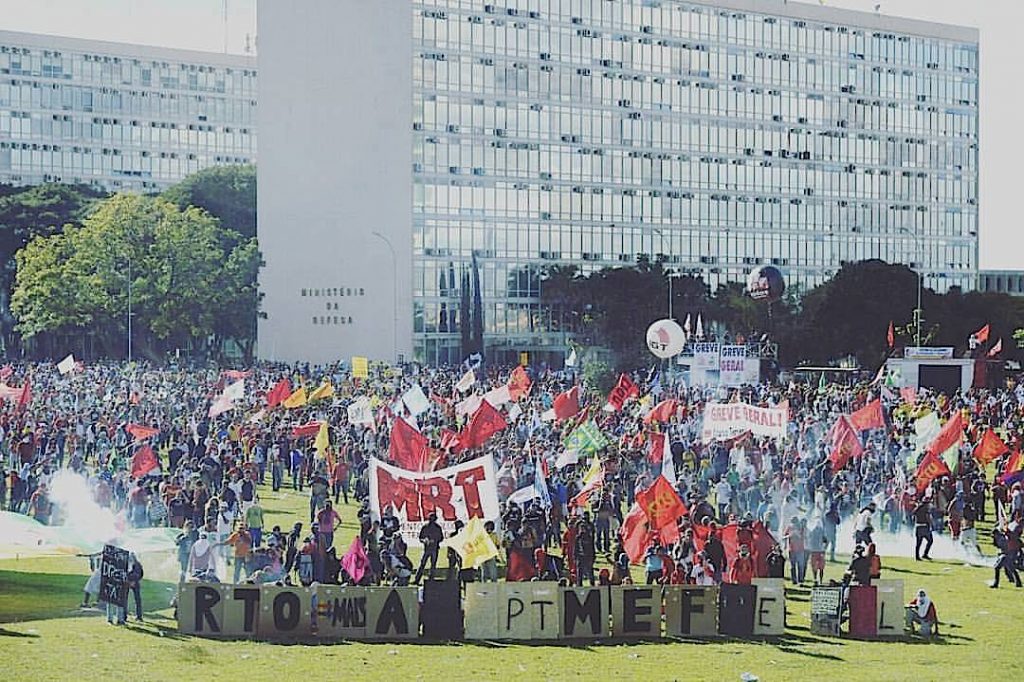
However, the Far Right is not the only political force attacking democratic rights. Various governments that define themselves as “moderates” or even “progressives,” have implemented states of emergency or repression against the workers and the poor. The Macron government in France, for example, mutilated dozens of protesters during the Yellow Vests’ uprising. This leap in repression against strikes and demonstrations has not been seen in decades. Similar repression took place in the Spanish State against the Catalonian independence movement and in defense of the monarchy. Various countries have used the supposed threat of “terrorism” to justify militarizing their police forces and carrying out anti-immigrant measures.
The pandemic has exacerbated these measures of social control with states implementing lockdowns, curfews, and states of emergency. In Latin America, the disastrous course of the Maduro government is an expression of how the regime’s increasing militarization — far from fighting imperialism — has served to attack workers, who have seen their salaries plummet (Now just $2 a month on average).
Those of us who fight for a workers’ democracy, based on organs of self-determination of the exploited masses, place ourselves on the front lines of struggle against any attack on democratic rights. In the Spanish State, our comrades of the Revolutionary Workers Current (CRT) have defended the just demands of Catalonians for the right to self-determination. This demand has been expressed in recent years with a series of mass demonstrations, actions by the youth, and the referendum of October 1, 2017. As part of this fight, we oppose the repression of the centralist and monarchist state and demand freedom for all political prisoners. At the same time, we reject the conciliatory policies of the bourgeois and petty bourgeois leaderships of the Catalonian movement and we point out the need for a strategy based on class independence. Our perspective must be a Catalonian socialist republic as part of the struggle for an Iberian Federation of Socialist Republics.
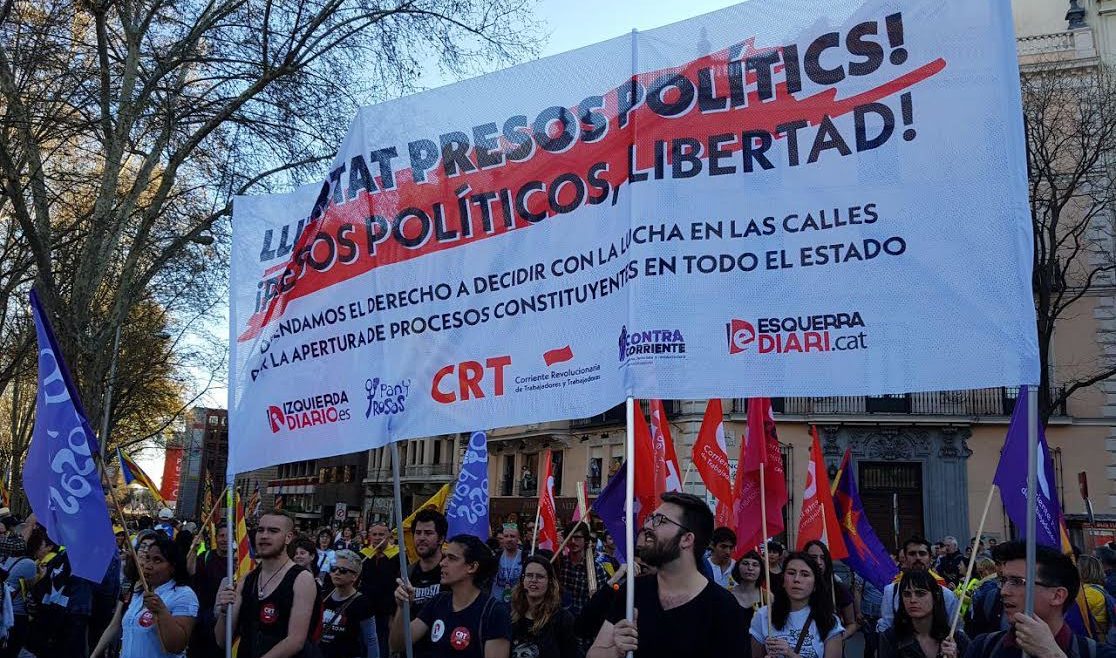
We oppose all attempts to curtail democratic rights and freedoms by regimes that increasingly repress the working class and the poor masses. We demand an end to militarization, states of emergency, and curfews, which are of no use to stop the pandemic. We call for an end to oligarchic institutions such as the senate and the authoritarian figure of the president, which concentrates enormous powers over working people. We defend the right to universal suffrage, without vetoes or restrictions. We call for the election of all judges and for trials by jury. We demand the formation of a single assembly of representatives elected by all people over the age of 13, without discrimination by sex or nationality. Such representatives should be recallable and earn no more than an average worker.
We call for an end to all reactionary anti-asylum laws. We demand the immediate closure of all detention camps and the opening of all borders to all asylum seekers. We call for an emergency plan that includes support for refugees, access to housing, full social and political rights, and access to work under the same conditions as documented workers. These are slogans that should be defended by the revolutionary socialist Left and the working class as a whole.
We raise all of these demands in defense of basic democratic rights. We also put forward radical democratic demands, however, based on the experiences of the Paris Commune and the Jacobin Convention. This is a way to accelerate the masses’ experience with bourgeois democracy, and to expose the capitalist regimes with their “democracies for the rich.” To confront both the reactionary Far Right and the Bonapartist tendencies, we strive to unite the struggle for democratic demands with a program for a workers’ government.
The Relevance of a Transitional Program to Face the Capitalist Crisis
The most immediate slogans that we put forward must be combined with others of a transitional, anticapitalist character. These demands aim to build a bridge between the present consciousness of the masses and the goal of socialism. Such demands will be met only through the development of class struggle. Millions of poor families suffer the effects of the current housing crisis and face evictions by police and the state’s repressive forces. We demand the expropriation of empty apartments in the hands of real estate companies and speculators to solve the housing crisis. As they raise rates in poor and working class neighborhoods, we demand the nationalization of utility companies. With such a program, we seek to unify the demands of the entire working class and to help sectoral struggles transform into a generalized struggle against the ruling class and the state.
In a different historical context, when most of the world was agrarian and rural, and far less urban and industrialized than today, the problems of combining working-class demands and those of other poor sectors were addressed by Leon Trotsky with his theory of permanent revolution and the Transitional Program. The theory of permanent revolution does not counterpose the struggle for specific social or democratic demands to revolution and socialism. On the contrary, by emphasizing the importance of these demands as motors of mass mobilization, it points out that such demands cannot be resolved in a comprehensive and definitive way if they are not connected to the struggle against capitalism — that is, the struggle to end private ownership of the means of production and build communism. When we speak of communism, we mean the same thing Marx did: a society of free producers, based on the abolition of private property, social classes, and the state, and an end to all forms of oppression. This would permit each person to develop their capabilities to the maximum and contribute to a society based on common needs.
Throughout 2020, big corporations and governments placed the costs of the economic crisis and the pandemic on the shoulders of the working class and the poor. As the Trotskyist Fraction, we call for elementary measures, such as the abolition of patents, to allow for the mass production and distribution of vaccines; 100 percent paid sick leave and increased quarantine salaries; debt forgiveness for small and medium-sized businesses; progressive taxes on large fortunes; and the centralization and nationalization of healthcare systems. We also call for other measures to confront the irrationality of capitalism and imperialism. These include a monopoly of foreign trade; the nationalization of the banking system under workers’ control; the nonpayment of the odious foreign debt, which forces countries to dedicate resources to the international economic vampires, and not to the needs of the people, even in times of severe crisis.
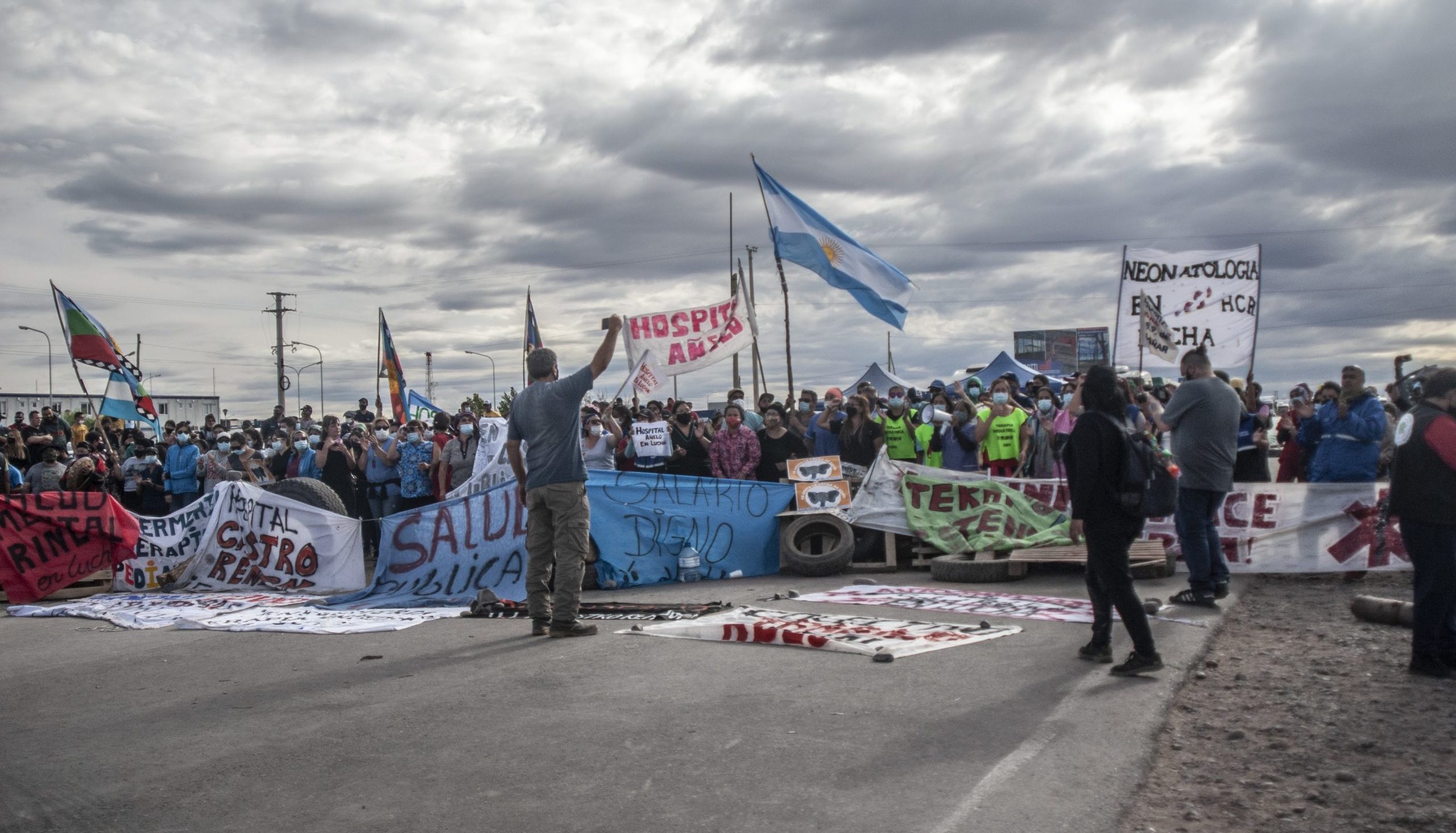
The bourgeoisie, but also reformist and neoreformist currents, call many of these measures “utopian.” It has become common sense that capitalism is the only system possible. Following this logic, we can only demand wage or benefit increases when the economy is growing. In periods of crisis, when businesses shutter, we should be content with severance pay.
Our program is socialist not because of doctrinairism. To protect the living standards of the masses, it is necessary to take measures against those who profit off the exploitation and precarious conditions of the working class and poor. The bourgeoisie uses inflation and rising costs of living as economic extortion. We fight for a sliding scale of wages and working hours. We call for occupation and workers’ control over any factory or workplace that closes or goes bankrupt — a fundamental measure to defend jobs. In the face of massive layoffs and unemployment, we fight for the distribution of working hours among the employed and unemployed without salary reductions. We call for the nationalization of the banks under workers’ control and a monopoly of foreign trade to end capital flight that only benefits the imperialist corporations.
Measures like this can be implemented only through the systematic struggle of the working class, based on organs of self-organization and defense. Workers’ and poor people’s councils, along with their respective militias, are key to installing a workers’ government that can put an end to the exploitation and misery to which capitalists condemn us. The current crisis is making many of the historical demands of the workers’ movement more relevant — demands that were systematized by Trotsky in The Transitional Program, which was adopted as a manifesto of struggle by the Fourth International in 1938.
The Importance of Developing Institutions of Self-Organization for Class Struggle
The working class has the social power to unite different sectors of the oppressed, but it must confront the bureaucratization of its own organizations and their subordination to the state. Trotsky dealt with this question in his reflections about the “statization of the trade unions,” on the basis of which he formulated a policy to intervene in the struggle against the bureaucracy. Antonio Gramsci similarly analyzed the evolution of the old trade unionism and its integration into the state, coining the term “integral state.” These elaborations from the interwar period remain relevant today.
During the neoliberal offensive, many of the gains of the so-called welfare state were eroded in many parts of the world. But the role of the trade union bureaucracy as the representative of the state inside the working class was maintained. In fact, its integration made an even greater leap in many countries, via bribes or through the direct transformation of workers organizations into bureaucratic business unions. In other cases, where the union bureaucracies are not so powerful in economic terms, the unions have followed social democracy and reformism’s shift to the right. They have been submissive in the face of attacks carried out by different bourgeoisies by arguing that they cannot confront them because “the relationship of forces is not in their favor.” In this way, they have divided the different sectors of the working class. New bureaucratic leaderships have also developed in social movements that are only indirectly related to the unions, such as the women’s movement, the environmental movement, and even the movements of unemployed workers, which are organized separately from the employed workers unions and base their demands on subsidies and other forms of state assistance.
The union bureaucracy is the main agent dividing the working class into different sectors, which often appear directly opposed to one another. This is why the working class needs to fight for the broadest union democracy by wresting control of the unions from the bureaucracies. The working class must fight for the independence of their organizations from the state. But to truly unify all the sectors of the working class and link their demands with those of all oppressed groups, new organizations must be built that go beyond the unionized minority of the working class, whenever the opportunity presents itself. We are referring to organs of self-organization for the rank and file that make it possible to unite our class and overcome the divisions between workers with permanent contracts and workers with temporary contracts, immigrants and nonimmigrants, and unionized and nonunionized workers. Such organs strengthen the vanguard and thus help constitute a workers’ movement independent of the state. Such a movement can raise the perspective of a government of the working class and the poor masses.
Since the crisis of 2008, mass movements have erupted and expressed themselves in different ways outside traditional channels — from the mass rallies in Taksim Square and Tahrir Square, to the territorial assemblies in Chile, or the cabildos in El Alto (Bolivia), among others. As the Trotskyist Fraction — Fourth International, we have supported the development of institutions of self-organization when we have participated in different experiences of class struggle. Our goal is to create effective mechanisms for making decisions and preparing for struggles. Here, we will mention a few examples.
In Argentina, as the Party of Socialist Workers (PTS), we have supported the formation of anti-bureaucratic rank-and-file organizations since the very beginning of our tendency. One of the most important experiences in this regard was the emblematic struggle of the Zanon ceramics factory in Neuquén, which has been under direct workers’ management for more than 20 years. In 2003, this occupation led to unity between the Ceramics Workers’ Union and the Movement of Unemployed Workers; later it created the Regional Coordinating Committee of Alto Valle, which united employed and unemployed workers and different militant sectors, including the class struggle groups that led the local teachers’ unions. This Coordinating Committee united the militant, anti-bureaucratic sectors, while at the same time placing demands on the union federation CTA for strikes and unity in action. It was thus able to converge in the streets with the unions organizing public-sector workers in the province. At the same time, the organized workers established an alliance with the indigenous Mapuche people — an alliance that continues today. We fought for the unity of employed and unemployed workers in the National Piqueteros Assembly, calling for a single movement of unemployed workers with freedom for all political tendencies, based on the demand for good union jobs. This struggle continues today. Starting in 2004, an anti-bureaucratic phenomenon swept through the industrial and transport workers’ movement in Argentina. This was known as “rank-and-file unionism.” In these different experiences, as well as in struggles by healthcare and education workers, we sought to develop rank-and-file organization, coordination between different sectors of workers, and unity with other poor sectors. In the same spirit, we intervened in the recent struggle for land and housing with its epicenter in Guernica, seeking the unity of different neighborhoods where occupations were being organized. We called for a unified assembly, instead of divided assemblies organized around whatever political tendency dominated each sector. We demanded that the union federations support the struggle of the families without homes, and called for unity with employed workers and the student movement. We were on the front lines in the confrontation with the repressive forces organized by Kirchnerism. At this very moment, the members of the PTS are participating in the processes of workers’ struggle that are emerging in Argentina, including the struggle of vineyard workers and the rebellion of the healthcare workers in Neuquén, which has paralyzed the province with pickets and massive support. The workers involved in these struggles are questioning the bureaucratic union leaderships and are attempting to build movements that unite different militant sectors. At the same time, we are demanding that unions and union federations organize actions against the erosion of wages, for safe working conditions, and in defense of workers and poor people not organized in the unions. That is why we defend the need for unity between employed and unemployed workers, breaking down the barriers imposed by the union bureaucracy and the state.
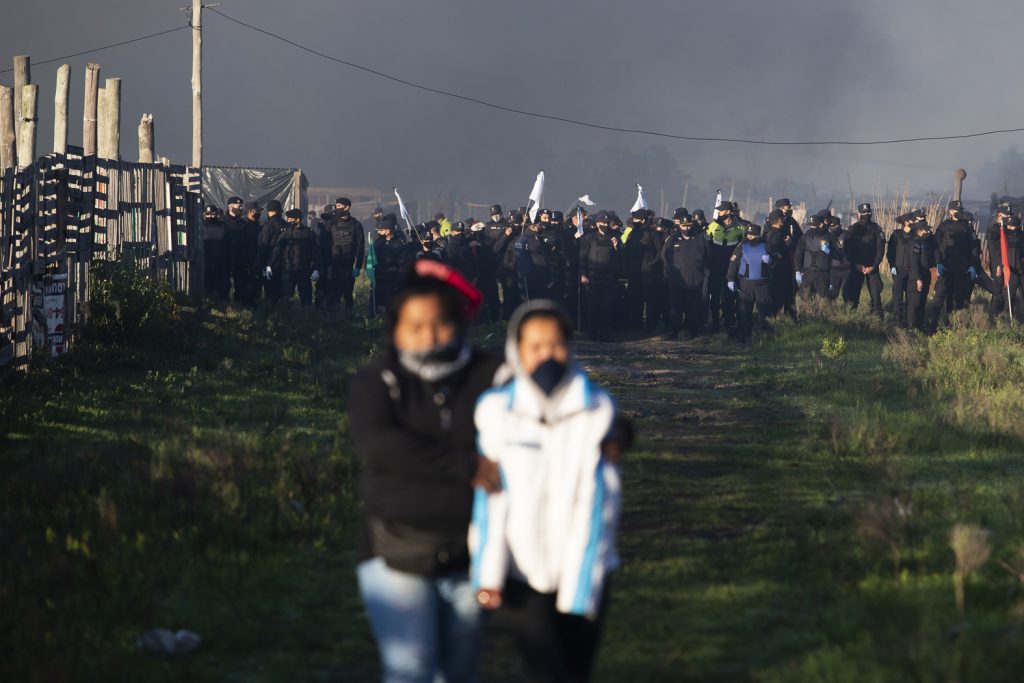
In Chile, the Revolutionary Workers Party (PTR) was one of the organizations that created the Emergency and Protection Committee in the city of Antofagasta. This organization brought together metalworkers’ and dockers’ unions, teachers, precariously employed youth, and committees from poor neighborhoods. It took the lead in initiating and organizing a general strike, based on the common demand for the fall of the Piñera government in the midst of the Chilean rebellion of 2019. Organizations like this allowed different sectors of the working class to coordinate with the “front line” of militant youth from the slums. The high point of the mobilizations was the general strike of November 12, 2019. An assembly of 400 delegates from different sectors attempted to shut down the city. Twenty-five thousand workers gathered in “Revolution Square.” A fighting wing of this movement denounced the criminal agreement that reformist organizations and the union bureaucracy of the CUT were attempting to reach with the government. This wing called for the revolutionary overthrow of the government. We were also part of the security committee of the Barros Luca Hospital in the Santiago neighborhood of San Miguel. This organization coordinated with surrounding neighborhoods, high school students, and workers’ organizations. To intervene in the general strikes, we sought to create coordination committees in the most important cities of Chile, such as Arica, Antofagasta, Santiago, Valparaiso, and Temuco.
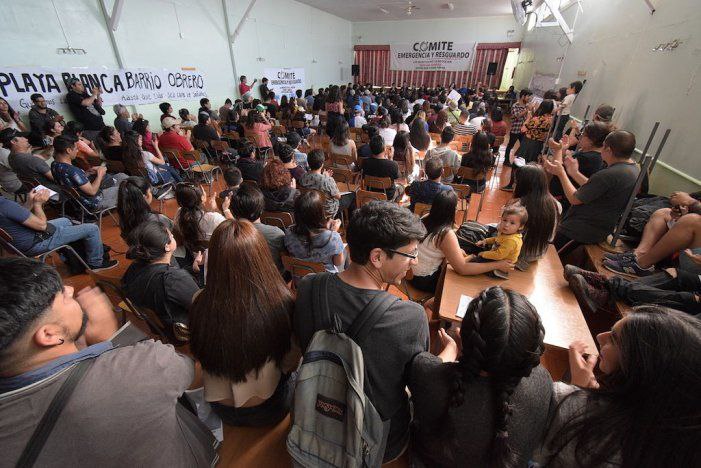
During the long struggle against the pension reform in France in 2020, members of the Revolutionary Communist Current (CCR) were at the center of the efforts to organize workers from the SNCF (national railways) and RATP (urban transport in the Paris region). This work played a decisive role in keeping the strike going while the union bureaucracies more or less openly called for a truce during the holidays at the end of the year. The coordination committee gathered more than 100 representatives from 14 bus depots (out of a total of 21), three subway lines, and two urban train lines. In effect, the committee presented an alternative to the union leaderships throughout the conflict.
Creating institutions of self-organization of the workers and poor masses prepares us for the coming battles in class struggle. We seek to deepen the alliance between workers and other oppressed sectors, and to fight the union bureaucracies and reformism, both of which were instrumental in diverting the recent rebellions that shook the world.
The struggle to develop bodies of self-organization is closely linked to the struggle for the unity of different sectors of the working class. It cannot be separated from a policy toward the big unions. It is necessary to develop revolutionary fractions in the union while simultaneously fighting for a United Front of the working class. This is the only way that the working class can emerge as an actor in the class struggle, and the most militant sectors can lead the masses.
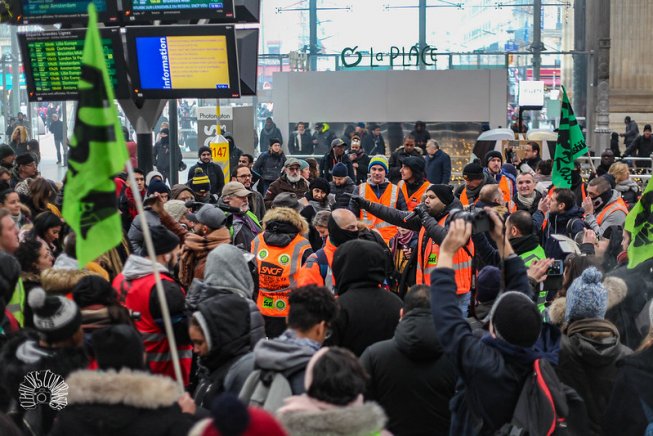
The Crisis of Neoreformism and “Progressive” Governments, and the Bankruptcy of Bourgeois Nationalism
The limits of neoreformism have been revealed by Syriza’s execution of the Troika’s austerity plans in Greece and Unidas Podemos’s transformation into an appendage of the social democratic PSOE in the government of the Spanish State. Opportunist political formations — which propose minimal reforms within the framework of the system while evading any question of capitalist property — channel social struggles into bourgeois institutions. This is an effective way to defeat or divert the demands of these movements.
The recent “progressive” and “post-neoliberal” governments in Latin America (such as those of Bolivia, Ecuador, and Argentina) attempted to repress the masses in the streets with lukewarm nationalist measures. This was the same method used by the bourgeois nationalist government in Venezuela. Others, like Brazil, acted preventively; when the working class and the poor masses rejected neoliberalism and austerity measures, the governments worked to channel this rejection into the bourgeois political system. These same governments began to implement austerity measures in the midst of an economic crisis that made their “redistributive” policies become more difficult.
Since the institutional coup against Dilma Rousseff in 2016, the subsequent rise of Bolsonaro, and the electoral victories of openly right-wing parties, these “progressive” forces have claimed to represent the “lesser evil” compared to governments that apply austerity measures and align themselves with the U.S. and the IMF. Nonetheless, the “progressives” who have returned to government, such as the Frente de Todos (Everybody’s Front) in Argentina, continue the basic policy of plundering the country, repaying debt to the IMF, and cutting pensions. Or, as in the case of Mexico’s President López Obrador, they carry out the policy of supporting the U.S. regime’s anti-immigrant policy and continue to militarize the country through the new National Guard and actions of the armed forces.
The politics of the MAS in Bolivia was particularly emblematic of this. While maneuvering to run for reelection, former president Evo Morales was toppled by a pro-U.S. civilian-military coup. The MAS, with a decisive influence on social movements, avoided staging a consistent struggle against the coup-instituted government of president Jeanine Añez. Instead, the MAS sought negotiations that would permit new elections. These finally took place under conditions imposed by the leaders of the coup. The disastrous management of the pandemic, racism against indigenous people, and division of the right allowed the MAS to triumph again. Former Vice President García Linera stated enthusiasm for a new “pink tide” in Latin America. Apologists for the MAS maintain that the victory in the new elections was the result of a “brilliant strategy” deployed by the party leadership against the coup. But this explanation ignores the masses’ resistance to the coup, including blockades, mobilizations, and confrontations with the army and the police, such as in Senkata. This struggle, carried out while the MAS leadership was engaged in negotiating with the coup’s leaders, is what defined the relationship of forces. The coup government could not reverse the trend created by this resistance. Mass resistance, alongside the catastrophic management of the pandemic, set the stage for the subsequent defeat of the right.
In Brazil, the Partido dos Trabalhadores (Workers’ Party) carefully avoided any serious fight against the Temer government. In fact, right-wing politician Michel Temer was even chosen to be Vice President under President Dilma of the PT. His administration emerged from the institutional coup against Dilma Rousseff. Further, the PT relied only on legalist maneuvers to fight against the attacks on Lula, which resulted in his imprisonment, the denial of his political rights, and the barring of his candidacy in the elections that put Bolsonaro in power. Lula later had to be released from prison, and as a result of the crisis of Bolsonaro’s government and his “denialist” response to the pandemic, Lula can now run for office again. Throughout this entire process, the PT’s policy has been consistent: they have engaged in verbal and legal opposition, but have avoided any kind of struggle in the form of mass mobilizations staged by the unions organized in the Central Única dos Trabalhadores (CUT), which the PT leads, or the poor masses in the northeast of the country that make up the party’s social base.In the case of Venezuela, the bankruptcy of bourgeois nationalism — as represented by Chávez — has been most dramatic, once again confirming the theory of permanent revolution. At the highest stage of its decay, chavismo has morphed into the quasi-dictatorial regime of Maduro, deploying major attacks against the masses and causing them great suffering. After oil prices fell, the Maduro government decided it preferred to pay the imperialist foreign debt rather than attend to the needs of the people and invest in the economic structure of the country. This policy led to an enormous economic and social catastrophe, which has been aggravated by the economic sanctions of U.S. imperialism and other imperialist powers. Maduro continues to pass anti-worker measures to plunder the country, using the “Anti-Blockade Law” as a cover and allowing foreign economic groups to buy Venezuelan companies at a low price. This also gives multinational companies and foreign creditors more control over the shares and the assets of oil fields and gas plants. Meanwhile, the government pulverizes wages and persecutes the sectors of the working class that organize to fight austerity measures. The general framework is one that strengthens authoritarianism.
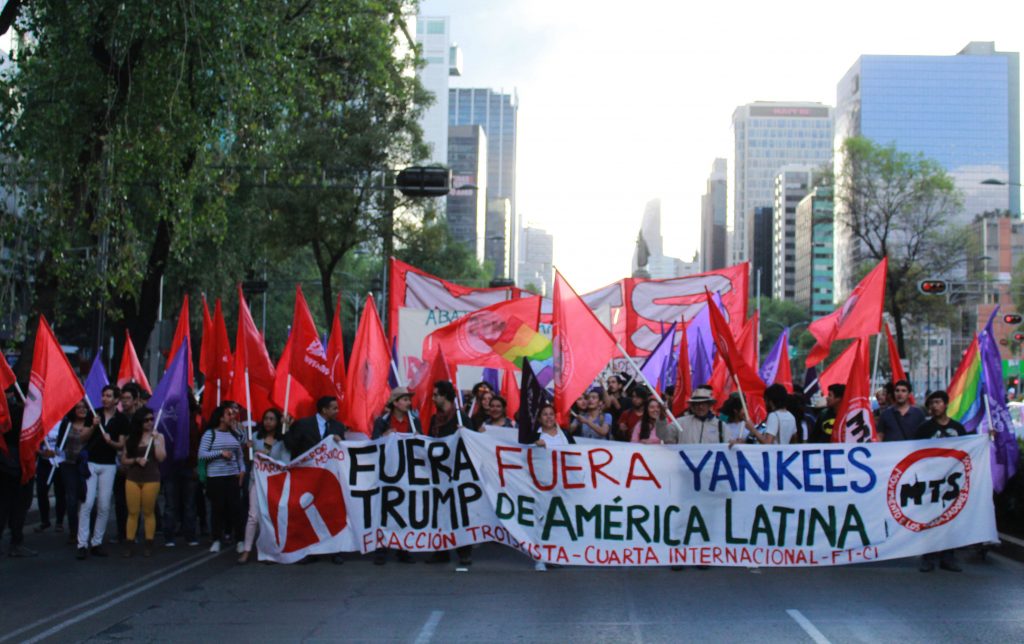
This list of examples could go on and on. The fundamental point here is that “neoreformism,” “progressive” governments, and bourgeois nationalism are not breaks with imperialism. They rely on the demobilization of the masses and maintain the essence of neoliberalism’s legacy, both in the central countries and in the periphery. In the case of Latin America, this means accepting compromises and making deals with imperialism, employing extractivism in all its forms: agribusiness, the oil industry, and polluting mega-mines.
Forces like the Frente Amplio (Broad Front) in Chile played a criminal role during the rebellion by signing a “peace agreement” that saved the Piñera government. This same neoreformist party voted for the anti-protest law that even today allows the government to keep hundreds of political prisoners in jail.
Only the working class and the poor masses can carry out consistently anti-imperialist policies. This means a break with all the treaties and deals that tie dependent and semicolonial countries to imperialism. Such a policy would include nonpayment of the foreign debt and a break with the IMF and international financial institutions. It would put foreign trade and the banking system under a state monopoly. These policies can be carried out only with a constant mobilization organized from below — with the perspective of uniting the working class of the oppressed countries with the workers of imperialist nations in order to defeat imperialism and capitalism.
It Is Necessary to Build Revolutionary Parties and a Movement for an International of the Socialist Revolution.
In recent decades, the forces of the Left have experienced important setbacks, which have affected many organizations that identify with Trotskyism. Even on the Left, the idea that capitalism was unbreakable proliferated, especially after the restoration of capitalism in Russia, China, and other countries; this was the mirror image of the previously exaggerated confidence in the conquests represented by the deformed and degenerated workers’ states under the leadership of Stalinists and Maoists. The bourgeoisie and imperialists presented neoliberalism as a universal dogma that was beyond question. They proclaimed that the capitalist system — a festival of consumption and infinite growth — would be eternal.
In the first two decades of the 21st century, we have seen these ideas proven wildly false. We have seen class struggle return again and again, led by the working class and different oppressed sectors. Neoreformist projects — such as Podemos in the Spanish State, or the Frente Amplio (Broad Front) in both Chile and Peru — claim that there are only two alternatives: either work within the framework of the system, or renounce mass politics. This means abandoning any serious struggle against capitalism, and the policy of building broad anticapitalist parties without any strategic delimitation has also shown its limits. This is evidenced in the final episode and likely implosion of the New Anticapitalist Party (NPA) in France. The NPA is in the midst of a crisis in which there is a debate between the old majority (aligned with the United Secretariat), which incessantly seeks coalitions with the institutional Left — including the nationalist reformism of Mélenchon — and tendencies like those of our comrades in the CCR, who believe a revolutionary workers’ party in France is both possible and necessary.
In opposition to reformist policies, we fight to build revolutionary parties rooted in the working class that fight for hegemony over all oppressed sectors. Such parties can build up revolutionary socialist fractions in the unions, among the youth, in Black and immigrant communities, the women’s movement, the climate movement, and among the masses of impoverished people. These fractions would converge with the most advanced sectors in class struggle, while simultaneously advancing mass politics against capitalism.To reach millions of people with this perspective, we have created the international network of online newspapers Left Voice / La Izquierda Diario. This network aims to produce revolutionary journalism aimed at the masses, including harsh criticism of the capitalist system and imperialism, by highlighting the struggles of the exploited and the oppressed. At the same time, we offer discussions that can be used by the vanguard to debate and decide how to advance the struggle for socialism until it is victorious. Our objective is to help the organization of an international revolutionary movement in a variety of languages. In addition to our newspapers and our participation in class struggle, we support different initiatives in the countries in which we have groups to unite the left on the basis of class independence. We have been part of the Workers Left Front (FIT) in Argentina since 2011 (today the Workers Left Front — Unity [FIT-U], composed of the PTS, the PO, Izquierda Socialista, and the MST). The FIT has transformed the Trotskyist Left into a real force in the national political arena; it is the only left-wing organization that is clearly independent of Kirchnerism and Peronism, with a program and practice of class independence. On the basis of this experience, and on a variety of occasions, we have raised the call to advance the debate about a unified party of the revolutionary socialist Left.
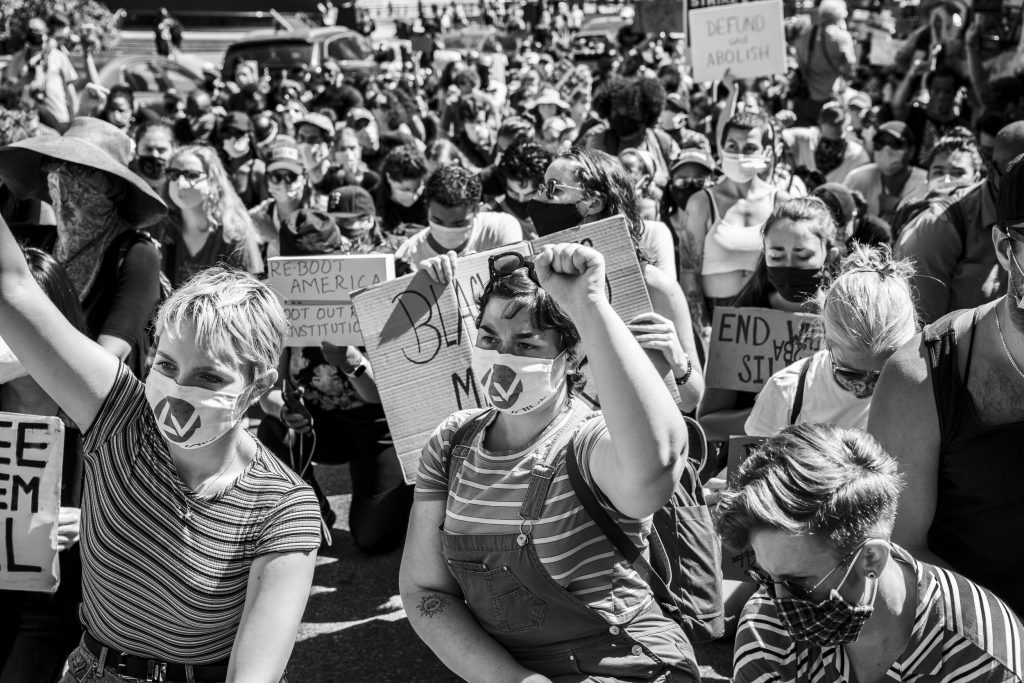
New sectors of young people and the working class are going to the streets to fight for a series of demands that cannot be solved definitively within the framework of capitalism. These sectors can be a starting point for an international recomposition of the revolutionary left. “Gen-Z,” those who were less than 10 years old when the 2008 financial crisis broke out, are today at the forefront of the struggles we have mentioned in this manifesto, and of many other struggles as well. Their whole lives have been marked by crisis, and many of them understand that they owe nothing to capitalism.
In the face of the disaster towards which capitalism is leading us, we have to raise both a program and a revolutionary solution. This means opposing both the extreme Right — which seeks to use “populist” demagogy to win a base of support among workers and youth suffering from the effects of neoliberalism — and the different varieties of neoreformism. For these reasons, we want to discuss the need for a movement to build a socialist international for revolution.
We must take up the internationalist tradition of the workers’ movement. The First International laid the foundations for the struggle to unite the worldwide workers’ movement. The Second International built mass parties and unions that did not pass the test of the First World War. The Communist International was founded after the betrayal of social democracy, building upon the Russian Revolution. It laid the basis for revolutionary tactics and strategy in its first four congresses (1919–22). The Fourth International, founded by Trotsky in 1938, was the only international organization that fought against both capitalism and fascism, while simultaneously confronting the bureaucratization of the USSR and posing a real alternative to Stalinism. After the Second World War, however, the Fourth International split into different tendencies that did not manage to uphold a revolutionary alternative and took on centrist positions where they oscillated between revolutionary and reformist positions. Nonetheless, the banners of the Fourth International continue to be valid in the face of the historic failure of Stalinism and the decay of capitalism. Against any sectarian self-proclamation, we maintain that the construction of revolutionary workers’ parties and an international party of social revolution — which for us means the refoundation of the Fourth International on a revolutionary basis — will not be the result of the evolutionary development of our organizations or our international tendency, but the result of the fusion of left wings of revolutionary Marxist organizations with sectors of the workers’ and youth oriented toward social revolution. Such sectors will emerge and be generalized in the heat of crisis and class struggle.
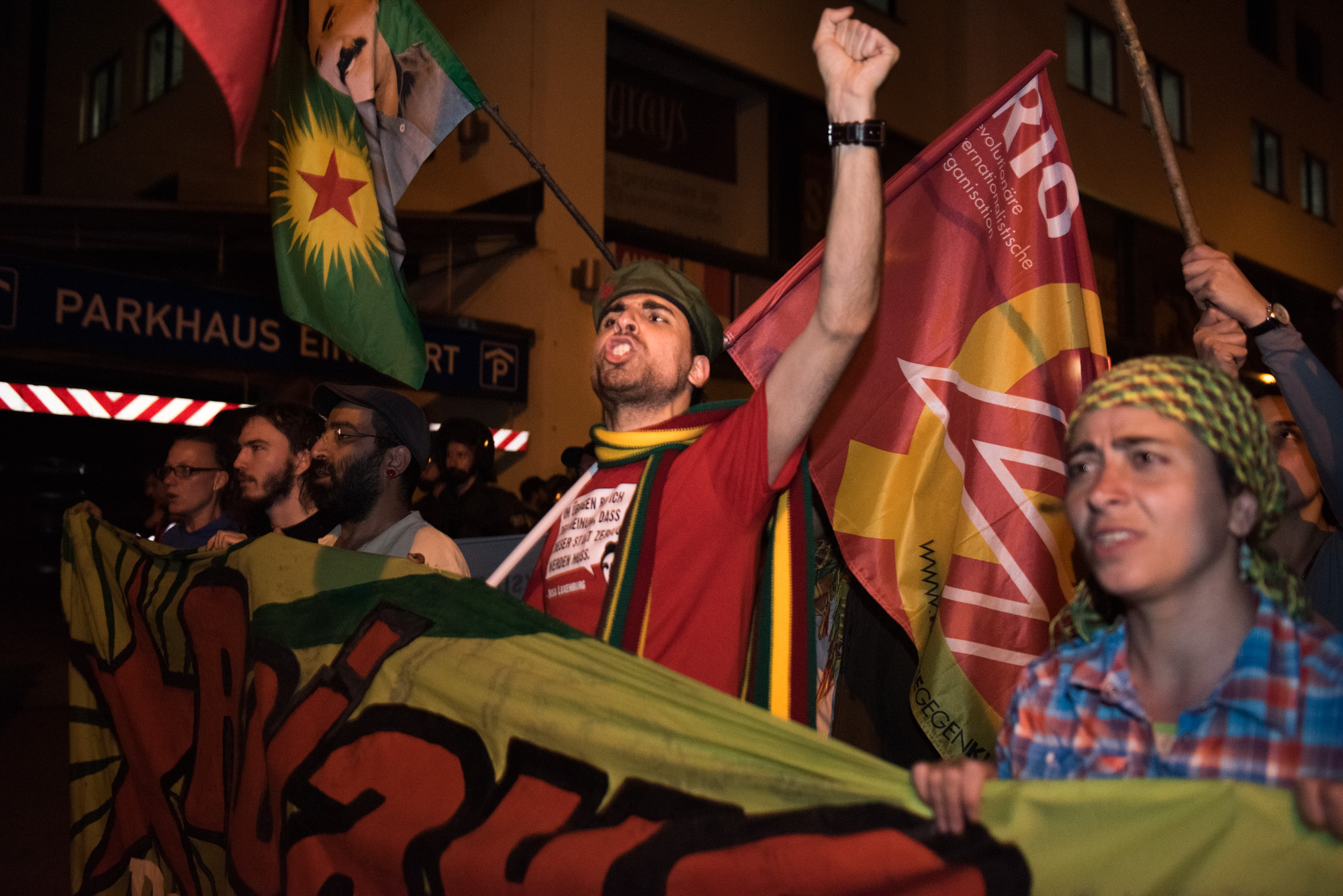
attacks and march in solidarity with the Kurdish movement.
Newer generations are unfamiliar with this tradition, with few exceptions. For this reason, we claim the heritage of Trotsky, but we do not demand that anyone accept our ideas without participating in a common experience with us, beginning with class struggle, and the main conclusions drawn from it. We believe that tendencies toward direct action and changes in ways of thinking are a fundamental starting point to construct revolutionary parties around the world.
The situation of the Trotskyist movement today — which is largely in retreat or relatively weakened — is related to the impact of the neoliberal offensive against the Left, but is also and above all related to the division of the Fourth International after the Second World War and adaptations to other political currents. This was an exceptional historical situation in which the agreements between imperialism and Stalinism on “peaceful coexistence” created a decades-long period of stability that the bourgeoisie could not even dream of during the interwar period. The upsurge of struggles from 1968 to 1981 showed the limits of this “glorious 30 years,” and also led to a questioning of Stalinism. But this upsurge was contained with concessions or defeated with repression. Thus the neoliberal offensive was able to shape the world we know today. For long decades, defending Trotsky’s ideas and revolutionary Marxist theory meant swimming against the current. It meant taking up the weak “threads of continuity” left by postwar Trotskyism, in order to connect with the past and the tradition inherited from Trotsky without seeing it through the distorted lenses of his “interpreters.”
The development of class struggle is creating new possibilities for the convergence of revolutionary Marxism and the workers’ movement. But in order for this to materialize, it is necessary to fight against the attacks of the ruling class in the here and now and not assume that mere reference to a tradition is enough to win influence among the vanguard and the masses. The tradition of Trotskyism must be rebuilt by drawing conclusions from the experiences of class struggle and the reality of capitalism today. In the context of a complex and difficult international situation, the task of building an international of socialist revolution becomes more and more urgent.
Such an international will not emerge from the unification of different Trotskyist groups, nor as a spontaneous product of social struggles. It is necessary to build a movement that fights for this goal — one that shows, in each experience of class struggle on a national scale, the necessity of the internationalist unity of the working class. We need an organization that can lead workers’ struggles against capitalism on the same terrain that capitalism uses: the entire world.
From our perspective, this international cannot be based on abstract, general principles, or a coordination of different anticapitalist movements. It cannot be created on this basis precisely because we fight the policy of the ruling classes that builds up bureaucracies of all kinds and erases the history of the working class and the oppressed. The banners of the Fourth International maintain their validity because this was the only organization to offer a theoretical, strategic, and programmatic alternative to the betrayals of Stalinism — something invaluable to those who engage in the struggle against capitalism and for a communist society today. The key for the future of the working class and all oppressed people lies in the convergence of this tradition with the new generations who have joined the struggle.
Signatories
The Trotskyist Fraction — Fourth International is made up of the following organizations:
Argentina: Partido de los Trabajadores Socialistas (PTS)
Brazil: Movimento Revolucionario de Trabalhadores (MRT)
Chile: Partido de Trabajadores Revolucionarios (PTR)
Mexico: Movimiento de Trabajadores Socialistas (MTS)
United States: comrades of Left Voice
Bolivia: Liga Obrera Revolucionaria (LOR-CI)
Spanish State: Corriente Revolucionaria de Trabajadoras y Trabajadores (CRT)
France: Courant Communiste Revolutionnaire (CCR), which forms part of the NPA (Nouveau Parti Anticapitaliste)
Germany: Revolutionäre Internationalistische Organisation (RIO)
Venezuela: Liga de Trabajadores por el Socialismo (LTS)
Uruguay: Corriente de Trabajadores Socialistas (CTS)
Italy: Frazione Internazionalista Rivoluzionaria (FIR)
Peru: Corriente Socialista de las y los Trabajadores (CST)
Costa Rica: Organización Socialista Revolucionaria (OSR)


